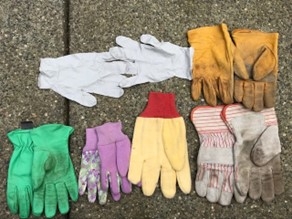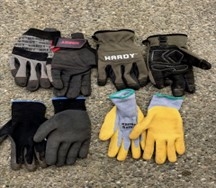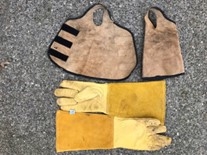As an ergonomic consultant, I have worked with businesses whose employees perform a lot of tasks requiring manual dexterity. Construction sites, wineries and high-tech clean rooms are good examples.
Almost without exception, these workplaces present situations that require gloves. Gloves protect workers from abrasions, pathogens, and chemical and thermal hazards. Gardening also falls into the category of jobs that require gloves.
With their bare hands in soil, gardeners can come in contact with sinister stuff that is not obvious to the eye. Did you know that soil can contain Clostridium tetani (which causes tetanus infections), Clostridium botulinum (which causes botulism), anthrax, Staphylococcus aureus, Escherichia coli and Listeria? Granted, these pathogens aren't commonly found in soil, but it happens, so why take a chance? Animal droppings and animal remains are the source of some of these contaminants.
These undesirables can enter the body via puncture wounds, abrasions, cuts, existing skin lesions, inhalation, or digestion. Bottom line: When you are working in the garden, keep your hands away from your nose and mouth.
As gardeners, we put our hands in all kinds of places, from muddy soil to gravel to thorny bushes—not to mention the many vibrating power tools we use.
Fortunately, there's a glove for every situation. Rubberized or lined gloves will keep moisture away from your skin when you're working in muddy areas. Leather gloves can protect you from abrasions when working in hard or dry soil. Latex or nitrate gloves are a good choice when you're working with delicate plants as they protect you while preserving dexterity. Elbow-length leather or Kevlar gauntlets may be necessary when you're working with thorny roses or woody shrubs.
If you are handling a chainsaw, lawn mower or leaf blower, the vibration can damage nerves in your hands. Padded gloves absorb some of the vibration, lowering the risk of numbness or carpal tunnel symptoms.
The only thing worse than working without gloves is wearing a pair that do not fit. You can lose 20 to 40 percent of your grip strength by wearing bulky or poorly fitting gloves.
I choose different types of gloves for different tasks. I prefer not to spend a lot of money on them as I go through them so frequently. Here are some of the gloves I find most useful:
Photo 1 (below): Top row (left to right): Nitrate gloves for delicate work. I also use them as liners for the leather gloves on the right. Bottom row (left to right): Green leather gloves for smaller hands; my granddaughter's purple gloves; yellow gloves, too loose fitting, useful only for warmth or tossing garbage; red-striped gloves, too bulky for most people, protect hands from sharp edges but are unsuitable for fine motor tasks. It takes more strength to hold items when gloves do not fit. Choose the right gloves for the task and be sure they fit.
Photo 2 (below): Top row: General-purpose gloves. The ones on the left side are flexible; the ones on the right have extra padding for use with vibrating tools. Bottom row: Rubberized gloves for working in wet areas; add a nitrate liner for more protection.
Photo 3 (below): Top row: Wrap-around leather sleeves that protect your forearms; paired with wrist-high gloves, they approximate gauntlet-type gloves. Bottom row: Leather gauntlets for work with roses or for weed clearing. There is also a version made with Kevlar.
In our homes, we protect our valuables. It would be wise to include your hands on that list of valuable possessions that deserve constant protection.
Photo credits: Bob Niklewicz
Workshop: Join UC Master Gardeners of Napa County for “Succulent/Dry Garden: Double Your Pleasure - Double Your Fun” on Saturday, July 27, from 10 am to noon, at Las Flores Learning Garden, 4300 Linda Vista Avenue, Napa. Do you know the five most common ways succulents reproduce? Learn their secrets and how you can increase your plant collection or add to your low-water landscape through succulent plant propagation. Register here.
Library Talk: Join UC Master Gardeners of Napa County and Napa County Library for a talk on “Fabulous Ferns, Indoors and Out “ on Thursday, August 1, from 7 pm to 8 pm via Zoom. Ferns are an accommodating family of plants ranging in size from tiny to behemoth. Some species grow in air and others in water, as well as in just about any type of soil. Enjoy an overview of these remarkable plants and find the perfect one for your space. Register to receive the Zoom link.
Help Desk: The Master Gardener Help Desk is available to answer your garden questions on Mondays and Fridays from 10 am until 1 pm at the University of California Cooperative Extension Office, 1710 Soscol Avenue, Suite 4, Napa. Or send your questions to mastergardeners@countyofnapa.org. Include your name, address, phone number and a brief description.
Become a Master Gardener Volunteer: UC Master Gardeners of Napa County is now accepting applications for the Class of 2025. Visit napamg.ucanr.edu to read the informational brochure, then register to attend a mandatory information session for applicants. Application deadline is 5 pm on September 25.
Attached Images:


